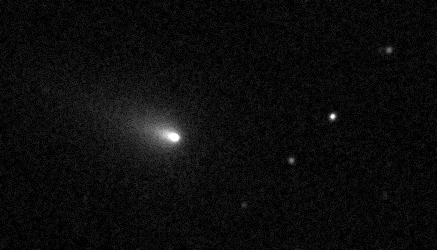Sky Over Swarthmore: Comet May Brighten May Sky
Throughout much of human history, the appearance of a comet in the night sky was an unexpected event, often thought to be significant. In the Bayeux tapestry depicting the Norman conquest of England in 1066, a crowd of people look up and see Halley’s comet appear just as Harold is crowned King of England. The inscription above their heads reads Isti mirant stella (“They marvel at the star”). The comet’s appearance was thought to foreshadow the invasion and, with it, Harold’s death at the Battle of Hastings.
We now know that comets – small icy bodies left over from the formation of the solar system – pass by Earth regularly. Astronomers discover dozens of them each year. Most of us are unaware that this is happening overhead because only rarely does a comet become bright enough to see with the unaided eye. This May, however, we may be fortunate enough to see a rare naked-eye comet. Or we may not.
Comet ATLAS, observed with the Swarthmore College Peter van de Kamp Observatory telescope on the night of April 2. The telescope was tracking the comet’s motion, so background stars appear as straight lines. Image: Eric Jensen / Swarthmore College Peter van de Kamp Observatory
Last December, as it scanned the skies for asteroids that might be on a collision course with Earth, the Asteroid Terrestrial-Impact Last-Alert System (ATLAS) discovered a new comet. Fortunately, this body — officially named Comet ATLAS C/2019 Y4 — is not headed directly our way. But it has generated excitement among astronomers nonetheless. Comet ATLAS has been rapidly brightening. If it continues to do so at its current rate, the comet will be easily visible in our evening skies in late May.
This month, Comet ATLAS is above the horizon all night in the northern sky, visible through small telescopes or even binoculars. Because it is still fairly dim, though, it is easiest to find with telescopes that can point to specific coordinates.
Given that we can predict its path, why don’t we know how bright it will become?
Why Comets Shine
To understand this, it helps to know more about comets. Astronomers sometimes call the main body of a comet a “dirty snowball.” It’s not a solid chunk of ice, but rather a loosely packed conglomeration of small particles of ice and rock. The body can be up to half empty space. Even with powerful telescopes, such icy bodies are too small to see until they come close enough to the sun that the ice starts to evaporate. This creates a cloud of gas and dust that envelopes the comet’s nucleus, forming the bright head, or coma. Like the word comet itself, this comes from the Greek word for hair. To ancient people, a comet appeared as a long-haired star.
This gas-and-dust cloud also streams away from the comet, forming a tail. The size of the tail depends a lot on whether the comet has passed by the sun before. Each passage removes some of the volatile material from the surface, depleting it over time. If the nucleus is not very tightly held together, that might make it easier for it to release material into a large tail. If Comet ATLAS has a loose nucleus and a long tail, it could be bright in the May sky. But not if it disintegrates completely as it nears the sun. Observations on April 5 hint that the comet’s nucleus is elongating. It may already be breaking up.
I recall vividly the two bright comets of the 1990s. In 1996, as I was finishing graduate school, I saw Hyakutake in the dark Wisconsin skies. The next year, after taking a job in Arizona, I was amazed by the surreal and beautiful sight of Hale-Bopp with its long tail suspended above the palm trees as I looked toward Phoenix at sunset.
I would love my children – love all of us – to have that experience. So I am hoping for a repeat performance, even if I don’t really expect it. Still, perhaps we will be lucky. Next month, we might be able to look up and, like the people in the Bayeux tapestry, marvel at a new “star.”
Eric Jensen is an astronomy professor at Swarthmore College.




